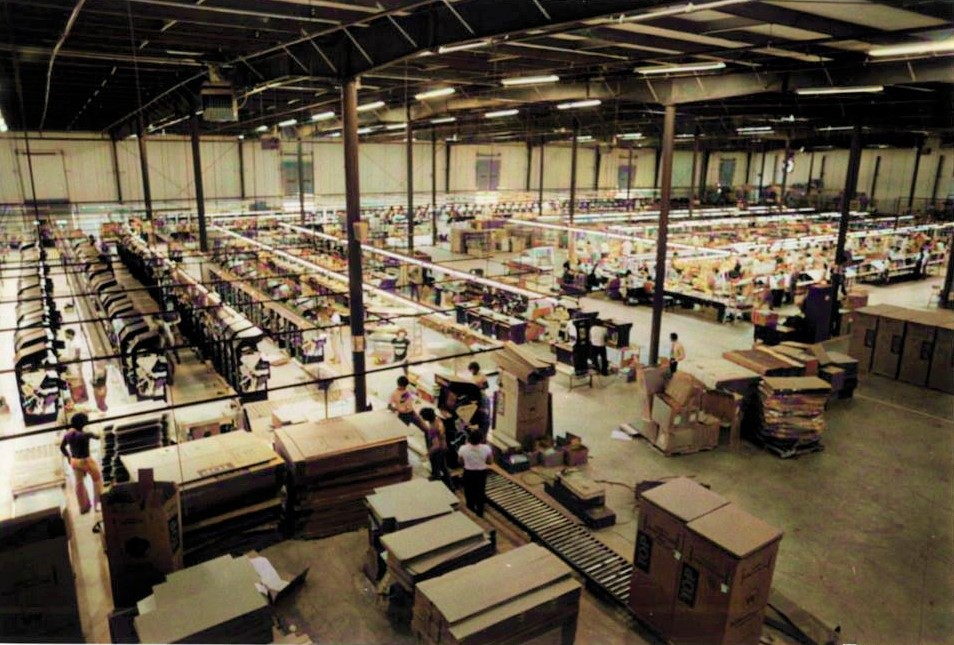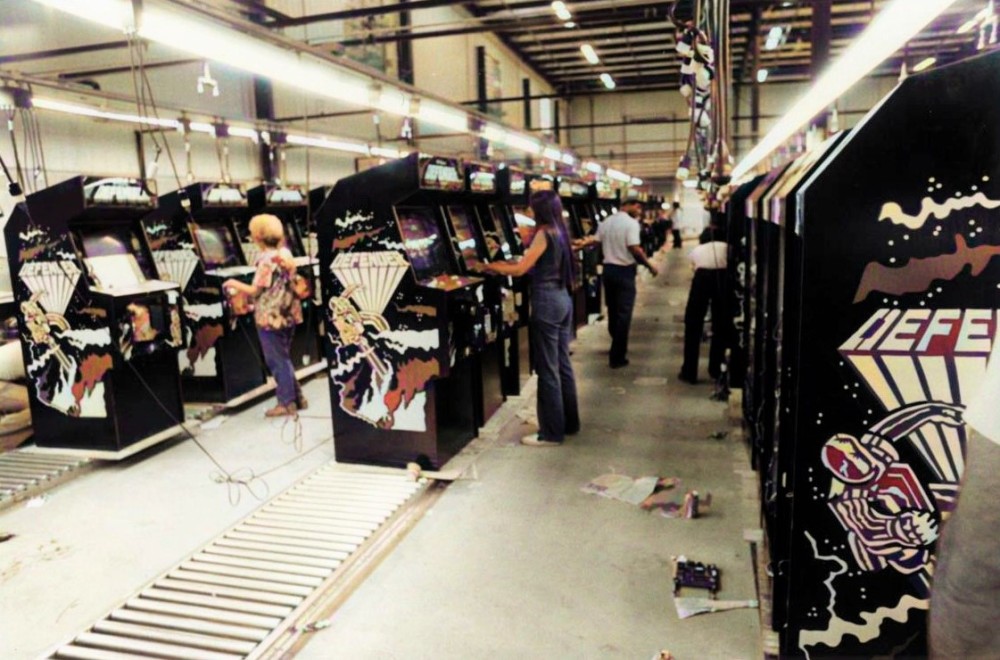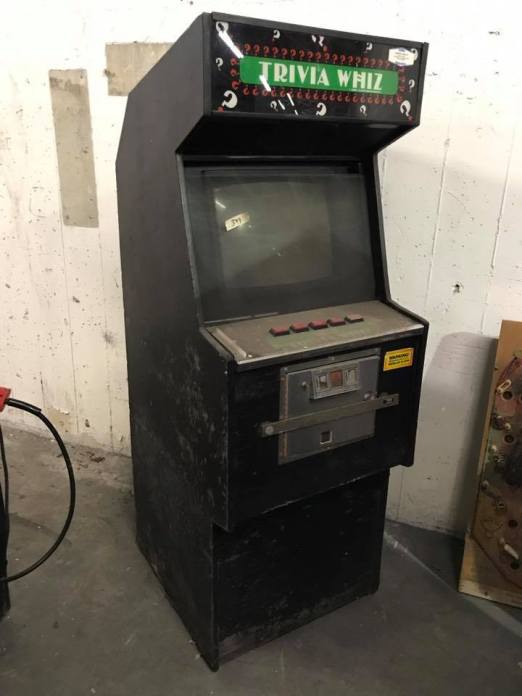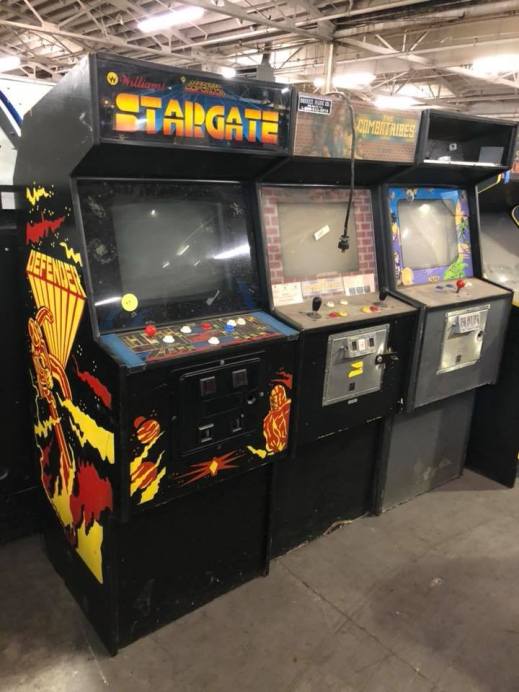It’s hard to resist Defender as a classic arcade game. Recognised as one of the best shoot-em-ups of all time, Eugene Jarvis’ monumental arcade game for manufacturer Williams remains top of the pile in every sense of the word. Aside from a Pong clone released a few years earlier, Defender was the first arcade game developed in-house and released by Williams.

After a fraught 9 month development cycle, Defender was first shown publicly at the Amusement and Music Operators Association (AMOA) Show in 1980. Response to the game was initially rather muted – due in no small part to the suited attendees being intimidated by the game’s infamous hard-as-nails difficulty. But the reception in arcades was electric. The game drew hordes of players armed with coins – it became a spectator sport with players three or four deep, waiting and craning their necks to watch whoever was playing get their ass handed to them in short order.

Operators caught on quickly, and Williams were inundated with orders for the hot new cabinet. Like Pac-Man, it was not unusual to see rows of Defender machines in a single arcade as arcade owners placed mulitple orders, so as to capitalise on the massive following the game was creating:

To meet this huge demand, Williams quickly opened a new 60,000 square foot manufacturing facility in Gurnee, Illinois. This allowed them to double their production capacity overnight.

For more pictures of the Williams arcade factory, check out my previous article here.
With over 55,000 cabinets eventually built and sold, Defender was a huge success for Williams. Having developed a multi million dollar earner for his employer, Wiz Kid Jarvis was given the green light to carry on developing great games such as Stargate and Robotron – both hits in their own right.



But it does beg the question: what happened to the 55,000 Defender cabinets that Williams eventually sold? We’ve discussed previously on the blog how long the typical shelf life was for any particular arcade game. As an arcade operator in 1980, your machines would have been your assets. Once players moved onto something else and a particular arcade title stopped taking money, ops had a few choices: Scrap it, store it somewhere, sell it (or rather give it away), or convert it to something else.
The good news obviously, is that there are still plenty of Defenders about. Look on eBay, or collector forums and you can pick one up pretty easily. Over here in the UK, Defender is always in demand. Buying one is a pretty safe bet, as they hold their value so well.

We can’t do much about the scrapped machines sadly. But many Defenders were repurposed and converted to play other, newer video game titles.
Rather than buying a complete new cabinet for thousands of dollars and scrapping the obsolete Defenders, operators could purchase just a PCB kit, or even acquire a cheap bootleg board of another title. This may or may not have included artwork for the marquee, control panel and sides. So, after giving it its last rites (optional), you could pull your unplayed Defender off the arcade floor, drag it into the workshop, remove the old PCB, marquee and whatever else needed ditching, and put your new kit into the shell of the old cabinet. Then just add a new lick of paint to remove traces the machine’s previous life.

Hey presto – you just updated your unloved arcade cabinet for a fraction of the cost.
Given the number of Defenders produced, it is not unusual to come across converted cabinets. Some of these were done well, and had a bit of care and love put into them. Others were just down right nasty, as you’ll see below.
In a rather tongue-in-cheek effort to show what happened to at least some of the cabinets, what follows are some interesting examples of what a few operators did with Defender when people stopped playing – all in an attempt to keep the money rolling in through the coin doors.
All of these cabinets have turned up for sale in recent months:




I find it interesting that whoever did these conversions would bother to paint over the great looking Defender artwork with flat black paint. Given the way most arcades were laid out, weren’t players unlikely to see the side art anyway?




That Fast Draw cabinet is a good example of how companies released specific kits so that operators could convert their existing dead inventory. New games would be advertised with marquees ready cut to size, control panels, and side art specific for the Defender shaped cabinets. This was smart thinking – with so many redundant Defender cabinets out there, this was a rich vein opportunity to go at – just drop the new kit in and you’re ready to start making money again – at a fraction of the cost of buying a new machine.




The irony of course is that now collectors are buying these cabinets up in order to reverse the original conversion! De-converting an arcade cabinet can be very satisfying, and at some point in your arcade collecting career, you’re going to have to get your hands dirty and fix a converted cabinet.
In the case of most of these machines, the biggest challenge will be finding original Defender PCBs and parts to put back in. Thankfully, modern JROK boards are more plentiful (and reliable) and tend to be the best solution for most collectors. Not ideal, but better than leaving most of these franken-cabinets as-is.
Another bunch here:




Three in one picture here:

I’ll leave you with this picture which I’ve shared before. Obviously as something of a purist, I’m not a fan of any conversions, but this one had so much care and attention put to it, we have to give props to the poor soul who was instructed to carry out this Defender conversion:

Of course the good news is that smart collectors can snap these ugly cabinets up for a few hundred dollars, get the paint stripper out, start removing the handy work of eighties operators, and bring these sleeping Defenders back to life. For some, it will be the only route to ownership.

Hope you enjoyed this fun look at these Defender conversions. And fear not: in the right hands, there’s hope yet for each and every one of these de-flowered classic arcade cabinets.
Thanks for reading this week.
Tony
Thanks to Lloyd at Coinopwarehouse for allowing me to share these conversion pictures here on the blog.

I can remember playing it in the arcades as a young chap but it was way too hard for me. There were some cracking ports to early computers/consoles such as the BBC and my favorate being Defender by Interceptor Software on the 64. Having started going to the Arcade Club in Bury, its a game that I always look out for for a good old blast. It truly is a timeless classic. Great post by the way, as a huge collector having over 140 computers/ consoles and probably 4,500 games to boot, please feel free to have a look at my work in progress and keep up the good work!
LikeLiked by 1 person
i have long dreamed of adding a Defender upright to my small collection. Maybe some day! I hadn’t considered that some of the cabs had been converted… it was such a popular game and so iconic that i just figured that the people who had the surviving ones were holding onto them like gold. Painting over a Defender cab? HERESY!
LikeLiked by 1 person
Great article Tony. I’m going to be looking out for Defender conversions everywhere now!
LikeLiked by 1 person
Defender what a great game! Remember back in the early 80’s being able to play for about 35 to 40+ minutes on one quarter. So into to it if my ship was destroyed seemed like my heart stopped for a second or two. Not sure I was blinking my eyes very much because after that long of play (don’t remember the level) my eyes would tear up so bad I couldn’t see….. Game Over!
LikeLiked by 1 person
Just brought home my defender yesterday and found this article today. We have some repairs to make but it will be worth it. Having an original Defender is going to be a lot of fun!
LikeLiked by 1 person
Awesome Terry! Defender is a great game. Good luck with the restore!
LikeLike
Any Idea how many Cocktails were made? Are these more more expensive than uprights?
LikeLiked by 1 person
Hey Tony. Not sure on cocktail numbers, but in the hundreds I would say. They tend to go for similar money over here in the UK.
LikeLike
Just noticed that Stargate in a DEFENDER cab is missing the invisio button oops
LikeLiked by 1 person